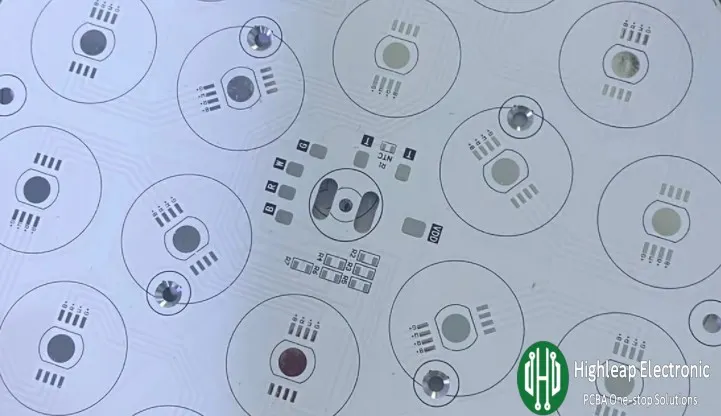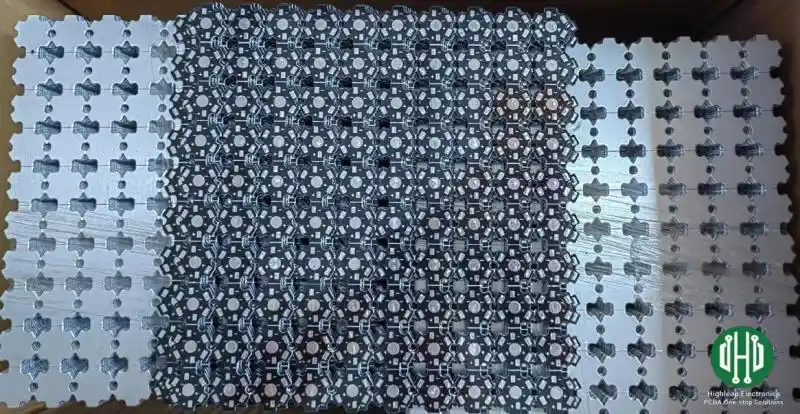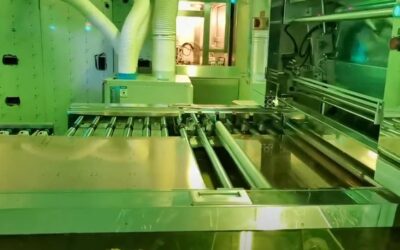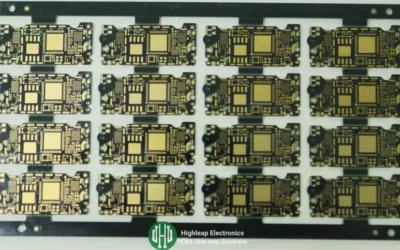Back to blog
Types of LED PCB Boards and Their Industry Applications

LED PCB Boards
LED PCB boards, known for their efficiency and versatility, play a crucial role in modern lighting solutions. This article delves into the intricacies of LED PCB boards, including their construction, types, applications, and benefits. We will also explore related components like MCPCB, LED circuit boards, and LED lamp PCBs, providing a thorough understanding for industry professionals and enthusiasts alike.
The Basics of LED PCB Design
Core Construction
The core of an LED PCB board can be made from various materials, each chosen based on the application’s specific needs. Common core materials include:
- FR-4: A fire-retardant composite of glass and epoxy, widely used but not optimal for heat dissipation.
- Epoxies: Cost-effective but less durable than other materials.
- Metal-core: Typically aluminum, alloyed with metals like magnesium and silicon, providing excellent thermal conductivity and electrical insulation.
Aluminum LED Circuit Boards
Aluminum LED PCBs are favored for their exceptional heat dissipation. They are structured in layers: the base layer is an aluminum alloy foundation, the thermal insulation layer is made from ceramic polymer to absorb and disperse heat, and the circuit layer consists of copper circuits designed per PCB specifications.
There are various types of aluminum LED PCBs: flexible aluminum allows bending and flexibility, hybrid aluminum combines aluminum with non-thermal materials for cost efficiency and rigidity, and multilayer aluminum features multiple layers of thermally conductive dielectrics for high-performance applications.
LED PCBs can be assembled using two main methods: surface-mount assembly, which mounts components directly onto the board’s surface, providing high connection densities, and thru-hole assembly, where components are placed through drilled holes and soldered, offering stronger connections suitable for extreme conditions.
These aluminum-based PCBs are essential for modern electronics due to their durability, efficiency, and versatility, making them ideal for a wide range of applications from consumer electronics to industrial lighting solutions.

LED PCB Boards
LED PCB Board Industry Application
Different types of aluminum LED PCBs include flexible aluminum, which allows bending and eliminates connectors, hybrid aluminum that combines non-thermal materials for cost efficiency and rigidity, and multilayer aluminum with multiple thermally conductive dielectric layers for high-performance needs. Assembly methods for these PCBs include surface-mount assembly, providing high connection density, and thru-hole assembly, ensuring robust connections ideal for extreme conditions. LED PCB boards are an integral part of various industries, such as:
Consumer Lighting: These boards are widely used in consumer lighting products such as flashlights, lanterns, lamps, and solar lighting systems. Their efficiency and durability make them the first choice for everyday lighting solutions.
Consumer Electronics: Due to their excellent thermal management, LED PCB boards are often used in devices such as computers, tablets, mechanical keyboards, smartphones, and TVs. They help maintain optimal device performance and lifespan by efficiently dissipating heat.
Telecommunications: In the telecommunications industry, LED PCB boards are used for indicators and displays. Their durability and superior heat transfer capabilities enhance the reliability and performance of telecommunications equipment.
Transportation: LED PCB boards play a crucial role in various transportation applications. They are used in vehicle headlights, brake lights, traffic lights, and aviation lighting. A notable example is Huawei’s innovative headlights, which not only illuminate but also project and display fonts and patterns, requiring the use of LED display screens and PCB control boards. The ruggedness and ability to withstand harsh conditions make LED PCB boards suitable for these critical applications.
Medical: The medical industry relies on LED PCB boards for hospital lighting and medical examination tools. Their reliability, energy efficiency, and effective thermal management are critical to ensuring consistent and safe performance in medical environments.
LED PCBs, with their adaptability and reliability, continue to be essential components across industries, driving innovation and efficiency.
The Advantages of Aluminum in LED PCB Boards
When it comes to LED PCB boards, aluminum stands out as a preferred material due to its remarkable properties suited for LED applications. One of the standout features of aluminum LED PCBs is their exceptional heat dissipation capabilities. High temperatures can be detrimental to electronics and LEDs, leading to reduced lifespan and performance, and affecting light quality and color. Thus, effective heat management is crucial, and aluminum excels in transferring thermal energy away from heat-sensitive components like LEDs.
Understanding LED PCB Boards
Aluminum’s efficient heat dissipation allows for more LEDs to be mounted on each board without overheating. Since LEDs generate significant heat, clustering too many together can create excessive thermal buildup. Aluminum PCB boards solve this problem by allowing more LEDs to operate efficiently without compromising performance. Additionally, prolonged use of electronic devices generates heat, and aluminum’s heat management capabilities enable continuous operation, thereby extending the lifespan of both the LEDs and the device itself.
Additional Benefits of Aluminum in LED Circuit Boards:
- Cost-Effectiveness: Aluminum is abundant and relatively easy to refine, making it less expensive than many other metals. This affordability extends to the manufacturing of aluminum PCBs, which are cheaper than other heat management solutions like heat sinks.
- Environmental Friendliness: Aluminum is recyclable and non-toxic, which helps reduce the carbon footprint associated with PCB production. This eco-friendly attribute also ensures safe disposal at the end of the product’s life cycle.
- Enhanced Durability: Aluminum PCBs are more robust compared to those made from fiberglass or ceramic. They are more resistant to damage during manufacturing and in end-use, making them suitable for products used in challenging environments.
- Lightweight Nature: Aluminum is lightweight, which simplifies the shipping and handling of aluminum PCBs. The combination of low weight and high reliability makes these boards ideal for use in automotive and other mobile applications.
By leveraging the advantages of aluminum, LED PCB boards not only ensure better performance and longevity of electronic devices but also contribute to cost savings and environmental sustainability.

Aluminum PCB LED Lamps
Types of LED PCB Boards
Different types of LED PCB boards are designed for various applications, each offering unique benefits.
Hybrid LED PCB Board:Hybrid LED PCB boards combine a base metal, typically aluminum, with a non-thermal material like FR4. This mix results in a board that is both sturdy and cost-effective, making it suitable for diverse uses.
Single-layer LED PCB Board:A single-layer LED PCB board features only one layer of copper conductive substrate. Copper is favored for its excellent conductivity. These boards are easy to design, budget-friendly, and versatile, making them ideal for a range of basic applications.
Flexible LED PCB Board:Flexible LED PCB boards are highly adaptable and can be twisted, bent, or folded into various shapes. This flexibility makes them preferable over rigid PCB boards for applications requiring movement or where space is limited.
Multilayer LED PCB Board:Multilayer LED PCB boards consist of multiple layers of copper conductive material separated by insulating layers. These layers are interconnected by copper-plated holes and held together by strong adhesives. Basic multilayer boards might have four layers, but more complex designs can include up to 50 layers, making them perfect for intricate and demanding applications.
Rigid LED PCB Board:Rigid LED PCB boards are made from solid, durable materials that serve as the substrate. These boards maintain their shape, making them ideal for devices like computers and remote controls where the board needs to remain fixed. Rigid PCB boards come in various configurations, including single-layer, double-layer, and multilayer designs, catering to different application requirements.
By understanding the various types of LED PCB boards, manufacturers and designers can select the most appropriate type for their specific needs, ensuring optimal performance and cost-efficiency.

Aluminum PCB LED Lamps
Analysis of LED PCB Board Application Instances in Huawei Cars and BYD Cars
In the automotive industry, the application of LED (Light Emitting Diode) technology has become increasingly prevalent, particularly in the realm of vehicle lighting and display systems. Two prominent Chinese automotive manufacturers, Huawei and BYD, have integrated LED PCB (Printed Circuit Board) technology into their vehicles, enhancing functionality, efficiency, and user experience. This analysis explores specific instances of LED PCB board applications in vehicles from Huawei and BYD, comparing their approaches and benefits.
Huawei Vehicles
Huawei, renowned for its telecommunications equipment, has ventured into the automotive sector with a focus on smart and connected vehicles. Their integration of LED PCB technology is a testament to their commitment to innovation and quality.
- Smart Headlights: Huawei utilizes LED PCB boards in their smart headlight systems, which offer adaptive lighting. These headlights automatically adjust the beam pattern based on driving conditions, improving visibility and safety.
- Interior Ambient Lighting: Huawei vehicles feature customizable interior ambient lighting powered by LED PCBs. This technology allows drivers to choose from a spectrum of colors and intensities, enhancing the cabin’s aesthetic appeal and providing a personalized driving experience.
- Digital Instrument Panels: The digital instrument panels in Huawei cars leverage LED PCBs to deliver crisp, clear, and energy-efficient displays. This technology ensures that critical driving information is visible under various lighting conditions.
BYD Vehicles
BYD (Build Your Dreams) is a leading electric vehicle manufacturer known for its emphasis on sustainable and innovative automotive solutions. The application of LED PCB technology in BYD vehicles underscores their dedication to efficiency and environmental consciousness.
- Energy-Efficient Taillights: BYD employs LED PCB boards in their taillights, which consume less power compared to traditional lighting systems. This efficiency aligns with BYD’s goal of reducing the overall energy consumption of their electric vehicles.
- Advanced Display Systems: Similar to Huawei, BYD integrates LED PCB technology into their vehicle display systems. These displays are used for infotainment, navigation, and driver assistance systems, providing high resolution and reliability.
- Battery Management Systems: In BYD’s electric vehicles, LED PCBs are crucial in the battery management systems. They help monitor and manage the battery’s performance, ensuring optimal efficiency and longevity.
Comparative Analysis
- Innovation and Functionality: Both Huawei and BYD leverage LED PCB technology to enhance the functionality of their vehicles. While Huawei focuses on smart and connected features like adaptive headlights and customizable interior lighting, BYD emphasizes energy efficiency and advanced display systems.
- Energy Efficiency: BYD’s application of LED PCBs in taillights and battery management systems highlights their commitment to reducing energy consumption, a critical factor for electric vehicles. Huawei’s use of energy-efficient displays also contributes to overall vehicle efficiency.
- User Experience: The customizable ambient lighting in Huawei vehicles and the advanced infotainment displays in BYD cars both enhance the user experience, albeit in different ways. Huawei’s approach is more focused on personalization, while BYD emphasizes high-tech functionality and efficiency.
The application of LED PCB technology in vehicles from Huawei and BYD illustrates the significant advancements in automotive lighting and display systems. Both companies demonstrate innovative uses of this technology to enhance vehicle performance, efficiency, and user experience. While their approaches differ, the underlying goal of integrating advanced LED PCB technology remains a common and crucial aspect of their automotive strategies.

Aluminum PCB LED Lamps
How to Reasonably Use LED PCB Board Technology to Improve the Performance of Electronic Projects
As a PCB engineer, offering practical advice to PCB manufacturers and electronic product developers on how to effectively utilize LED PCB board technology to enhance project performance involves focusing on several key areas:
Optimize Circuit Design and Thermal Management
Efficient power management is crucial. Integrate high-efficiency power management modules to ensure stable LED operation while minimizing energy loss. Thermal management is equally important. Arrange LEDs and other heat-generating components properly and employ effective thermal solutions, such as heat sinks and thermal vias. This approach will significantly extend the lifespan of the LEDs and improve the overall stability of the system.
Select High-Quality Materials
Choosing the right materials for LEDs and PCBs is essential. Opt for high-quality LEDs with attributes like high brightness, low power consumption, and long lifespan to ensure reliability. Additionally, use premium PCB materials such as FR4 or aluminum substrates, which offer excellent thermal conductivity and high-temperature resistance. These materials will enhance heat dissipation and ensure the durability of the circuit.
Implement Intelligent Control and Optimize Layout
Intelligent control mechanisms, like Pulse Width Modulation (PWM), can be used for dimming, allowing precise brightness control and energy savings. Protection circuits against overcurrent and overvoltage are necessary to safeguard the LEDs and other components. A compact and efficient PCB layout minimizes trace lengths and reduces electromagnetic interference (EMI), improving signal integrity. Finally, consider incorporating advanced features such as smart controllers, sensors, and wireless control options to enhance functionality and user experience, fully leveraging the potential of LED PCB technology.
By focusing on these strategies, PCB manufacturers and electronic product developers can significantly improve the performance, efficiency, and reliability of their projects using LED PCB board technology.
Conclusion
LED PCB boards are indispensable in modern lighting solutions due to their efficiency, versatility, and superior heat management capabilities. This article has explored the detailed construction, types, and applications of LED PCB boards, highlighting their critical role across various industries. With aluminum as a standout material for its thermal properties, LED PCBs offer enhanced performance and longevity for electronic devices. For industry professionals seeking reliable, high-performance PCB solutions, Highleap Electronic offers cutting-edge technology and expertise in LED PCB manufacturing, ensuring optimal results for your projects.
FAQs
1. How can advanced thermal simulation tools improve the design of LED PCB boards?
Advanced thermal simulation tools allow engineers to model and predict the heat distribution and dissipation in LED PCB designs accurately. By using these tools, designers can optimize the placement of components, improve thermal pathways, and select appropriate materials to ensure efficient heat management and enhance the overall reliability of the LED PCB.
2. What are the benefits of using automated optical inspection (AOI) in the production of LED PCB boards?
Automated optical inspection (AOI) provides rapid and accurate inspection of LED PCB boards during production. It helps in identifying defects such as misalignments, soldering issues, and component placement errors early in the manufacturing process, reducing the likelihood of defective products and improving overall quality control.
3. How does the integration of IoT (Internet of Things) technology enhance the functionality of LED PCB boards?
Integrating IoT technology into LED PCB boards allows for remote monitoring and control of lighting systems. This connectivity enables features such as automated dimming, real-time performance tracking, and predictive maintenance, which enhance energy efficiency, extend the lifespan of LEDs, and provide users with greater control and customization.
4. What are the environmental considerations in the disposal and recycling of LED PCB boards?
Environmental considerations in the disposal and recycling of LED PCB boards include the proper handling of hazardous materials, the recovery of valuable metals like copper and aluminum, and the reduction of electronic waste. Implementing eco-friendly recycling processes and designing PCBs with recyclable materials can minimize environmental impact and promote sustainability.
5. How can advanced materials like graphene improve the performance of LED PCB?
Graphene, known for its exceptional electrical and thermal conductivity, can significantly enhance the performance of LED PCB. Using graphene-based materials can reduce electrical resistance, improve heat dissipation, and allow for thinner and more flexible PCB designs. This can lead to more efficient, durable, and compact LED lighting solutions.




